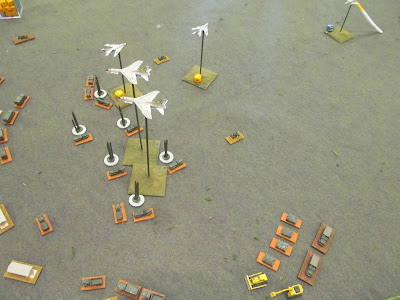With the run of the calendar to a new year, it is time to take a quick look back at 2017 and forward to 2018. Before I start that, I again want to thank all of you that read my blog on a regular (or not so regular) basis. I really appreciate the views and comments about what I'm doing. So, thanks for reading.
Reviewing 2017
I had limited goals for 2017 and only really finished a portion of those. The early part of 2017 was take up with work for Enfilade and I knocked out two planned projects:
The Cuban Missile Crisis goes hot joint project with my friend Kevin.
The Greenland-Iceland-UK Gap Harpoon Captain’s Edition game with 1/6000 scale miniatures.
I felt like both Enfilade projects were successful. The games went well and it seemed like the players had a good time.
For non-Enfilade projects I planned to:
Finish my Chinese Navy Type 054A frigate and some Japanese missile boats.
 |
| Almost completed ships |
I really procrastinated on these, starting and stopping them throughout the year. The kits are basically done, except for some touch-up paintwork, putting decals on the frigate, and basing the missile boats. So, I feel like this rates an 80% completion.
Work my modern submarine rules. This was pretty much a failure for the year. I tinkered around the edges, but I had a hard time getting into the final work on the rules. Hopefully, I can change that in 2018.
What else did I do? I did my usual summer solo project, which I combined with International Naval Wargaming Day, but that didn’t require any modelling or painting. I pulled out my Falklands models and painted up some Sea Harriers for the NHMGS Game Day at the Museum of Flight.
I also spent more time playing around with some computer games in 2017, with Cold Waters and Twilight Struggle being the main culprits of sucking up free time.
Overall, it wasn’t a bad year. Although I didn’t get in as much miniature and face-to-face gaming as I would have liked, but it wasn’t bad.
Previewing to 2018
Looking ahead to 2018, I’ll be working with Kevin on a couple joint Enfilade projects for the Falklands (this will be an improved and polished version of what we did at the Museum of Flight) and the attack on
HMS Illustrious in January 1941. I've got an old Aoshima version of the carrier ready to put together and I'm looking at what paint job she had in early 1941.
 |
| Ready for the slipway |
I’m also going to look for an Enfilade game to run by myself, but I will probably just recycle an old project for the game.
Based on discussions with some other gamers and other things I’ve got on the back burner, it seems like 2018 will be more air oriented for gaming and side projects. But there are a couple other things that are on my list.
I would like to get back to my modern submarine rules and let a few people look at/comment on the rules and ideas. I just need to figure out something to get me motivated again.
 |
| Waiting for orders |
I also decided to get some figures for some Crusades era Lion Rampant armies. I’m going to start with the Muslim/Turkish army. I picked up some boxes of Gripping Beast plastic figures and, using the sample retinues from Lion Rampant, I figure I can cover the Seljuk Turks, Spanish Muslim, and Egyptian armies. I’m a pretty slow figure painter, so we’ll see how it goes.
 |
| Arab figures for Lion Rampant |
Other Odds and Ends: I’m hoping to get in more face-to-face gaming this year, so that might take priority over some of the non-Enfilade projects. I’m also sure there will be some other new, bright, and shiny game/object that will take my attention. Looking far into 2018, I expect DANG will take up the last couple months of the year and since I let the gamers vote on the project, it is hard to know what it will be.
Finally, I want to wish all of you a Happy New Year!




























